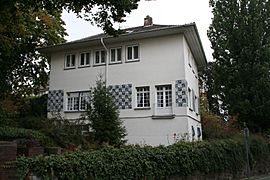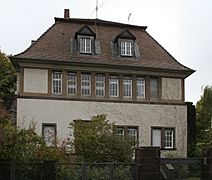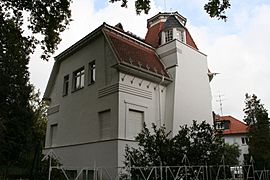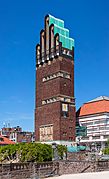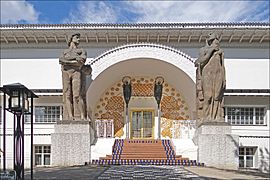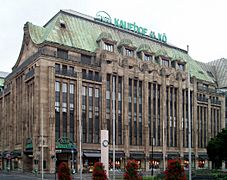Joseph Maria Olbrich facts for kids
Quick facts for kids
Joseph Maria Olbrich
|
|
|---|---|
 |
|
| Born | 22 December 1867 Opava, Austrian Silesia
|
| Died | 8 August 1908 (aged 40) |
| Nationality | Austrian |
| Occupation | Architect |
| Awards | Prix de Rome (1893) |
| Buildings | Secession hall |
Joseph Maria Olbrich (born December 22, 1867 – died August 8, 1908) was a famous Austrian architect. He was one of the people who started the important art group called the Vienna Secession. This group helped create the Art Nouveau style. Olbrich designed many buildings, including the well-known Secession Hall in Vienna.
Contents
Early Life and Education
Joseph Maria Olbrich was born in Opava, which was then part of Austrian Silesia. Today, this area is in the Czech Republic. He was the third child of Edmund and Aloisia Olbrich. His father owned a successful business that made sweets and wax. He also owned a brick factory. This is likely where young Joseph first became interested in building things.
Olbrich studied architecture at two important schools in Vienna. First, he attended the University of Applied Arts Vienna. Then, he went to the Academy of Fine Arts Vienna. He was a very talented student and won several awards. One of these awards was the Prix de Rome. This prize allowed him to travel to Italy and North Africa. These trips helped him learn even more about architecture.
Starting His Career
In 1893, Olbrich began working for Otto Wagner. Wagner was another famous Austrian architect. Olbrich likely helped design many parts of Vienna's Metropolitan Railway, known as the Wiener Stadtbahn.
In 1897, Olbrich joined with other artists like Gustav Klimt, Josef Hoffmann, and Koloman Moser. Together, they started the Vienna Secession art group. This group wanted to create new and modern art. Olbrich designed their main exhibition building, the Secession Hall. This building became a symbol of their new art movement.
Darmstadt Artists' Colony
In 1899, a special place called the Darmstadt Artists' Colony was created. It was started by Ernest Louis, Grand Duke of Hesse. Olbrich was invited to design many buildings there. He designed several houses, including his own home. He also created various exhibition buildings for the colony.
In 1900, Olbrich became a citizen of Hesse, a German state. The Grand Duke also made him a professor. In 1903, Olbrich married Claire Morawe.
Later Works and Influence
In the years that followed, Olbrich worked on many different building projects. He also experimented with applied arts and design. This means he designed everyday objects, not just buildings. He created pottery, furniture, book covers, and even musical instruments.
One of his most famous works was at the Louisiana Purchase Exposition in St. Louis, USA. This was a big world's fair. Olbrich designed a special courtyard and interiors for the fair. His work won the highest award there. People in the United States were very impressed. The St. Louis Post-Dispatch newspaper wrote that his pavilion would "leave a permanent mark upon American life." Because of his success, he was made a member of the American Institute of Architects.
Olbrich's architectural designs, especially his exhibition buildings, had a big impact. They strongly influenced the development of the Art Nouveau style. This style used flowing lines and natural shapes.
Final Years
Joseph Maria Olbrich's daughter, Marianne, was born on July 19, 1908. Sadly, shortly after her birth, Olbrich became very ill. He died from leukemia in Düsseldorf on August 8, 1908. He was only 40 years old.
Notable Works
- The Secession Hall, Vienna
- Residence for Hermann Bahr, Vienna
- Hochzeitsturm (Wedding Tower) and other buildings at Darmstadt Artists' Colony, Mathildenhöhe, Darmstadt
- Department store for Leonhard Tietz, Düsseldorf
- Villa for Josef Feinhals, Cologne (destroyed in World War II)
Gallery
See also
 In Spanish: Joseph Maria Olbrich para niños
In Spanish: Joseph Maria Olbrich para niños




